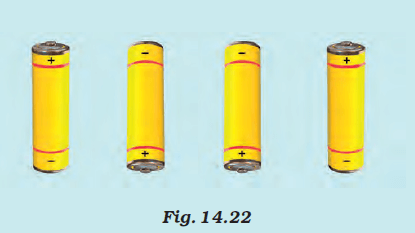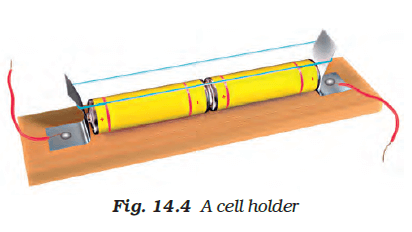NCERT Solutions for Class 7 Science Chapter 14 - Electric Current and Its Effects
NCERT Solutions for Class 7 Science Chapter 14, "Electric Current and Its Effects," are of paramount importance for Class 7 students. These solutions have been thoughtfully provided to facilitate a comprehensive understanding of the chapter in an engaging and straightforward manner. Expert subject teachers have meticulously crafted these NCERT Solutions, aligning with the latest CBSE syllabus for the academic year 2023-2024. Consistent practice of these solutions is essential to prepare effectively for the annual examinations. Access the PDF for Class 7 Chapter 14 Science NCERT Solutions below.
Access Answers to NCERT Solutions for Class 7 Science Chapter 14 - Electric Current and Its Effects
Students can access the NCERT Solutions for Class 7 Science Chapter 14 - Electric Current and Its Effects. Curated by experts according to the CBSE syllabus for 2023–2024, these step-by-step solutions make Science much easier to understand and learn for the students. These solutions can be used in practice by students to attain skills in solving problems, reinforce important learning objectives, and be well-prepared for tests.
Electric Current and Its Effects
The bulb in the circuit shown in Fig.14.23 does not glow. Can you identify the problem? Make necessary changes in the circuit to make the bulb glow.
In the circuit above, the bulb is connected on either side.
Draw in your notebook the symbols to represent the following components of electrical circuits: Connecting wires, switch in the ‘OFF’ position, bulb, cell, switch in the ‘ON’ position, and battery.
Draw the circuit diagram to represent the circuit shown in Fig.14.21.
Fig.14.22 shows four cells fixed on a board. Draw lines to indicate how you will connect their terminals with wires to make a battery of four cells.

Name any two effects of electric current.
i) Heating effect of electric current
ii) Magnetic effect of electric current
When the current is switched on through a wire, a compass needle kept nearby gets deflected from its north-south position. Explain.
When the current is switched on through a wire, the magnetic field is created around it hence we see deflection in the compass needle kept nearby.
Will the compass needle show deflection when the switch in the circuit shown by Fig.14.24 is closed?
No, the compass needle does not show deflection when the circuit is closed, and the magnetic field is not created until the current is flowing through the circuit.
Fill in the blanks:
(a) Longer line in the symbol for a cell represents its ________ terminal.
(b) The combination of two or more cells is called a _________.
(c) When the current is switched ‘on’ in a room heater, it _______.
(d) The safety device based on the heating effect of electric current is called a ______.
(a) Longer line in the symbol for a cell represents its positive terminal.
(b) The combination of two or more cells is called a battery.
(c) When the current is switched ‘on’ in a room heater, it produces heat.
(d) The safety device based on the heating effect of electric current is called a fuse.
Mark ‘T’ if the statement is true and ‘F’ if it is false:
(a) To make a battery of two cells, the negative terminal of one cell is connected to the negative terminal of the other cell. (T/F)
(b) When the electric current through the fuse exceeds a certain limit, the fuse wire melts and breaks. (T/F)
(c) An electromagnet does not attract a piece of iron. (T/F)
(d) An electric bell has an electromagnet. (T/F)
a) False
b) True
c) False
d) True
Do you think an electromagnet can be used for separating plastic bags from a garbage heap? Explain.
No, because plastic does not have the magnetic property to get attracted to a magnet; hence magnet cannot be used to separate plastic bags.
An electrician is carrying out some repairs in your house. He wants to replace a fuse with a piece of wire. Would you agree? Give reasons for your response.
It is not a wise idea to replace the fuse with a piece of wire, as it has a very low melting point. In the case of the metal piece, the melting point will be high, and the circuit will be intact in case there is overload or overheating.
Zubeda made an electric circuit using a cell holder shown in Fig. 14.4, a switch and a bulb. When she put the switch in the ‘ON’ position, the bulb did not glow. Help Zubeda to identify the possible defects in the circuit.

The reasons may be as follows:
i) The connecting wire may be loose
ii) The electric cell may be used up
iii) Switch may not be functioning well
iv) Cell power has been exhausted
In the circuit shown in Fig. 14.25
(i) Would any of the bulb glow when the switch is in the ‘OFF’ position?
(ii) What will be the order in which the bulbs A, B and C will glow when the switch is moved to the ‘ON’ position?
i) No, the bulb will not glow as the circuit is not complete when the switch is off.
ii) If the switch is ‘ON’, all the bulbs glow simultaneously.
Admissions Open for 2025-26
Frequently Asked Questions
The NCERT solution for Class 7 Chapter 14: Electric Current and Its Effects is important as it provides a structured approach to learning, ensuring that students develop a strong understanding of foundational concepts early in their academic journey. By mastering these basics, students can build confidence and readiness for tackling more difficult concepts in their further education.
Yes, the NCERT solution for Class 7 Chapter 14: Electric Current and Its Effects is quite useful for students in preparing for their exams. The solutions are simple, clear, and concise allowing students to understand them better. They can solve the practice questions and exercises that allow them to get exam-ready in no time.
You can get all the NCERT solutions for Class 7 Science Chapter 14 from the official website of the Orchids International School. These solutions are tailored by subject matter experts and are very easy to understand.
Yes, students must practice all the questions provided in the NCERT solution for Class 7 Science Chapter 14: Electric Current and Its Effects as it will help them gain a comprehensive understanding of the concept, identify their weak areas, and strengthen their preparation.
Students can utilize the NCERT solution for Class 7 Science Chapter 14 effectively by practicing the solutions regularly. Solve the exercises and practice questions given in the solution.

